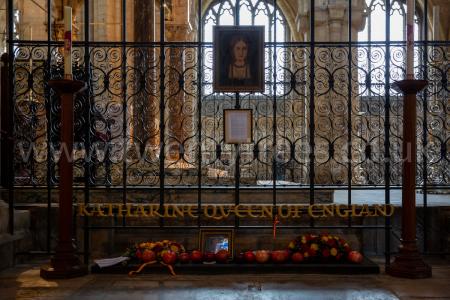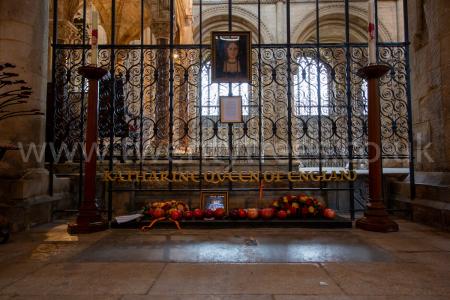Biography of Bishop John Hilsey -1539
Wriothesley's Chronicle 1538. 24 Feb 538. This yeare, the 24th daie of Februarie, beinge the Soundaie of Sexagesima and Sainct Mathias daie, the image of the roode that pouie was at the Abbey of Bexley [Map], a in Kent, called the Roode of Grace, and their was brought to Poules Crosse, and their, at the sermon made by the Bishopp of Rochester,b the abuses of the gracesc and engines,d used in old tyme in the said image, was declared, which image was made of paper and cloutes from the legges upward; ech legges and armes were of timber; and so the people had bene eluded and caused to doe great adolatrie by the said image, of long contynuance, to the derogation of Godes honor and great blasphamie of the name of God, as he substancially declared in his said sermon by scripture, and also how other images in the Church, used for great pilgrimages, hath caused great idolatrie to be used in this realme, and shewed how he thincketh that the idolatrie will neaver be left till the said images be taken awaie; and that the boxes that they have to gather the devotions of the people were taken awaye first, so that they should have nothing used to putt the charitie of the people in; but if their were any persons that would ofFree to such images, that the said offring might be geaven incontynent to poore people, and that the people, should be shewed howe they should ofFree no more to the said images, he doubted not butt then in short tyme they would grant that the said images might be taken awaie; also, he said, how he confessed a woman twentie yeares agoe in Oxford, which woman was the miller s wief, by the Abbey of Hailes, and how she shewed him how the abbott of the same place had given her manye Jewells that had bene offred ther at the holie bloode,a and how he would have geaven her one Jewell which she knewe verie well hanged about the said holie bloode, and said to the said abbott that she would not have that "bloude,"b2 because she was afraid because it hanged by the holie bloud, and the abbott said tush! thou art a foole, it is but a duckes bloode; and this the said bishopp shewed that it was true, as he besought God he might be damned if it were not so as he said; and also how he had shewed the King and the Counsell of the same, and that it should be knowen more openlie afterward; also, after the sermon was done, the bishopp tooke the said image of the roode into the pulpitt and brooke the vice of the same, and after gave it to the people againe, and then the rude people and boyes brake the said image in peeces, so that they left not one peece whole.
Note b. Bishop John Hilsey.
Note c. Probably a clerical error for vices, as in another place we read "the bishop broke the vice."
Note d. This rood or automaton, besides rolling its eyes and moving its lips, was so constructed that, by means of springs or vices, it could be made to bow, and shake its head, hands, and feet. See Herbert, p. 213, and Stow, ed. 1G31, p. 575.
Note a. Another great imposture was at Hales in Gloucestershire, where the blood of Christ brought from Jerusalem was showed in a chrystal vial, and was said to have this property: That if a man was in a mortal sin, and not absolved, he could not see it. Therefore, every man that came to behold this miracle was forced to continue to make presents till he bribed Heaven to give him the sight of so blessed a relic. This was now discovered to be the blood of a duck renewed every week, and one side of the vial was so thick that there was no seeing through it, but the other was trans parent. It was so placed near the altar that anyone in a secret place behind could turn which side he pleased outward. Lord Herbert in Kennett, vol. ii. p. 213.
b2. A clerical mistake for "jewel.";
Wriothesley's Chronicle 1530-1539. After 24 Jun 1535. Allso this yeare, after mydsommer, Dr. Fox (age 39), the Kinges almoner,b was made Bishopp of Hereford, and the black friere of Bristowec was made Bishop of Rochester, and Dr. Latimer (age 48) Bishop of Worcester, which men were great furtherers [of the Reformation],d in their preachinges, shewinge the abusions of the Spiritualtie, and allso how the worde of God ought to be preached syncerelye and purelye.
Note b. Edward Fox (age 39), Archdeacon of Leicester, and Provost of King's College.
Note c. John Hilsey, Prior of the Dominican Friars in London, appointed Bishop of Rochester, October 4, 1535.
Note d. These words are not in MS.
On 18 Sep 1535 Bishop John Hilsey was consecrated Bishop of Rochester by Archbishop Thomas Cranmer (age 46) at Winchester Cathedral [Map].
On 04 Oct 1535 Bishop John Hilsey was appointed Bishop of Rochester following the execution of Bishop John Fisher.
On 29 Jan 1536 Catherine of Aragon (deceased) was buried at Peterborough Cathedral [Map] at a service for a Princess rather than Queen.
Bishop John Hilsey preached, alleging that, in the hour of death, she had acknowledged that she had never been Queen of England.
Eleanor Brandon Countess Cumberland (age 17) was Chief Mourner. Henry VIII (age 44) refused their daughter Mary (age 19) permission to attend. On the same day Queen Anne Boleyn of England (age 35) miscarried a child.


William Harvey (age 26) attended; the only officer of arms to do so.


Wriothesley's Chronicle 1536. 13 Feb 1536. The seconde sermon, being on Septuagesima Sundaie, their preached at Powles Crosse [Map] the Bishop of Rochester.a
Note a. John Hilsey, Prior of the Dominican Friars in London, appointed 4th October, 1535, to this see, then vacant by the execution of Bishop Fisher.
On 09 Dec 1537 Bishop John Hodgkins was consecrated Bishop of Bedford by Bishop John Stokesley (age 62), Bishop Robert Parfew aka Warton and Bishop John Hilsey.
On 24 Nov 1538 Bishop John Hilsey preached at St Paul's Cross [Map] and showed the blood of the abbey of Hales [Map], affirming it to be clarified honey and saffron (Holinshed, pp. 275, 946). He similarly denounced the Rood of Grace of Boxley, exhibiting its machinery and breaking it to pieces (Stow, Annales, p. 574; Burnet, Hist. of the Reformation, ed. Pocock, i. 385, vi. 194).
In 1539 Bishop John Hilsey died.